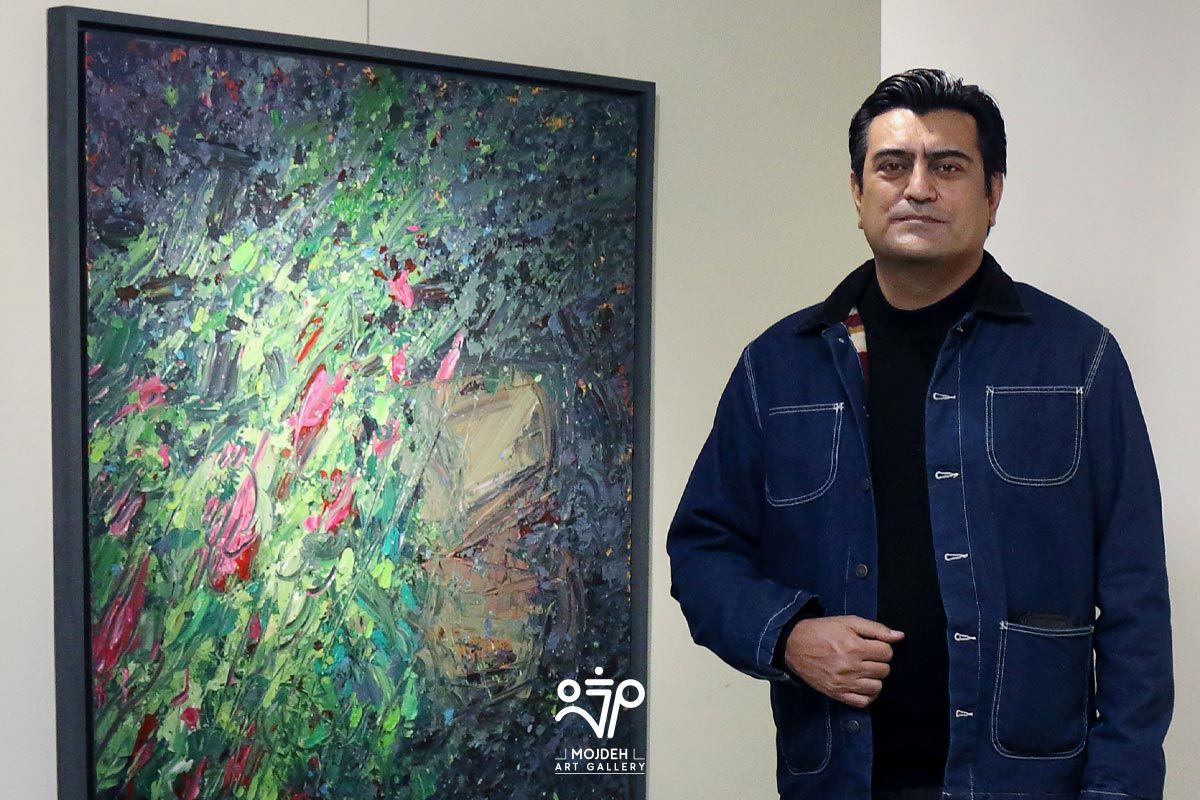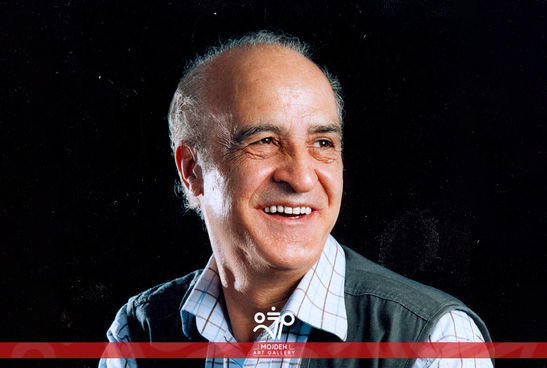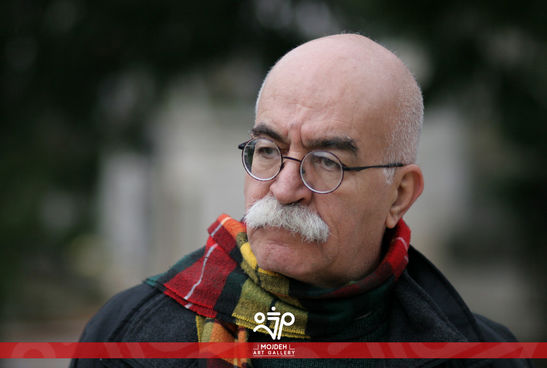The Protest that is Behind this Act of Painting

My type of painting was not formed suddenly, but it happened in a long and eventful process of change, which I can't say that I chose, but all I can say is that itis a kind of protest to the painting , to the history of my art , to the realist artists whose understanding of the realist school of painting has degraded to the level of beautifying. They have not understood the greatness of realism and do not know that photography is different from painting. This is a protest against my past, when I was a painter and I enjoyed it, now I am an artist and I suffer . Ashraf Porhashem wrote in Etemad Newspaper: Alireza Asanloo , a painter and sculptor who is famous for his successful sculptures of Kiarostami, Shajarian, Entezami and etc. With an aesthetic approach, in a contemporary border between realism and abstraction and adding originality to the element of the viewer's imagination, he has reflected elements of Hedayat figures in multiple layers of color, which has been very well received in Mojdeh Art Gallery.
“We’ll Meet at the Resurrection” is the title of this collection of paintings , which is one of the famous sayings of Sadegh Hedayat , and you probably expect to meet Mr. Sadegh Hedayat upon entering Mojdeh Art Gallery, who said goodbye to his life in a very sad and tragic way at the age of 48.; But the ten paintings in this exhibition will lead you to a conceptual and meaningful meeting , the painter who is the same age as the subject, and creates sculptures that exactlymatch withthe subject . In the world of paintin gconsciously immerses the subject in layers of paint , sometimes with a brush, sometimes with a spatula, sometimes with a finger on the canvas , and behind the current emotions created through fingertips , the face disappears and every audience is guided to the Sadegh Hedayatthat they read and know themselves .
We have had a conversation with him under the pretext of this show
- What happened that Sadegh Hedayat became the subject of the exhibition at Mojdeh Art Gallery ?
Asanloo: : Some characters cannot be deleted , even if they are thepain or tthereatment themselves ... The history of contemporary art of Iran has some myths who have destroyed the petrified values, a backward society , they have scoled the troubledpeople, so that their way of life becomes a current and their works be an opening toawareness .
Sadegh Hedayat, for me is not a writer or an artist that I study his works, so that I as a painter to depict his stories, or to have an analysis of his thoughts, what Hedayat created is clear and illustrative itself, of course if we are receptive.
Hedayat for me is an atmosphere, the space that can be seen through Hedayat’s glasses is exciting and shoking, The facts of everyday life are interwoven and lead to a surrealistic atmosphere, and this bleak surrealism does not have the strength of the mythological themes hidden in the millennia of previous civilization, and it leads to a contemporary expression in a short story by Hedayat. You can't be an artist and not go through Hedayat, you can't not read his works and become contemporary. I have nothing to do with the subject of his works because it is not in my field of knowledge. I look at the issue from the perspective of art structure and artistic nature, painting in the atmosphere of Hedayat was a necessity for me. It was not a choice, it is interesting to say, this collection of paintings has another theme called " We’ll Meet at the Resurrection ", something similar to the face that others say is Sadegh Hedayat, and I am watching what these works create in the audience. If the atmosphere of my paintings requires another narrator, I stand aside and watch.
- Why did you choose the phrase “We’ll Meet at the Resurrection” as the subject of the exhibition?
Asanloo: We’ll Meet at the Resurrection, Sadegh Hedayat's latest writing, summarizes the worldview of a person who lived quickly and drew his works from the hearts of the masses of people and became out of reach before he became a target of anti-elitist assassination, and to those who followed him, whether hostile or friendly, he gave the message that I am here... although in the Day of Resurrection. Usually, in our culture, this sentence is used when a person is afraid of a change in circumstances or facing a power, and in order to release his anger, he promises to meet in the Day of Judgment, or in the case of love failures and meaningful relationships, he promises to meet then. It is given to the hereafter, this necessity is felt in all aspects of our life today, sometimes we cannot stand to the power of the oppressor and we take our vengence to the doomsday. What better name than this, to make us feel good and calm our anger.
- Is it necessary to look for Sadegh Hedayat’sphilosophical view of in these portraits?
Asanloo: No, Sadegh Hedayat hid himselfin terms of appearance , that means, in his works, a narrator who is not Sadegh Hedayattells a story , he is an actor and plays a role all the time so that what is happening inside him wont be revealed. By looking at his photo album you can never see him (except one photo) always calm and well-dressed, a well-dressed man in a suit and formalwear, even at a picnic where all friends are naked and sunbathing and happy, Hedayat is sitting in a suit and tie… the actor is always occupied. He doesn’t let anyone to see behind his mask, we don’t get anything from the photos, we have to find him through these photos, for many years I didn’t have the courage to do so and I couldn’t, many times I tried to paint Hedayat in a realistic way but it turned out just like him!!! I tried to paint his portrait many a dozen of times and when I looked at it, he would make fun of me and simle, I would finish the painting at night, and in the morning he would look at me and make fun of me. I was in agony that why did I start this project and why don’t I work more like other painters, I can choose to paint any subject and why don't I paint beautifully to be admired, why did I get involved in this matter that my opponent is bigger than me and more powerfull ... and hundreds of other reasons that plagued me every day... But life has taught me a great lesson that I will never forget: "Stop Knowing” Everything that originated from my knowledge, did not do anything for me, did not bring me growth, and everything that came from not knowing was helpful and painful... and has reached awareness.
When I put down the brush and picked up paint with my hands and grabbed the canvas, it didn't become a painting but I felt better, the contrast between what I learned and the concept of painting by hand removed the medium that made me a painter, it allowed me not to paint but to see the identity, not to draw eyes but to create the look, not to paint the mouth but to reveal the expression in my works...
Maybe the answer to your question is: don't look for anything in these works, just be with them.

- Did you read Sadegh Hedayat from your youth?
Asanloo: Yes. I didn't understand it when I was a teenager, and I read it again ten years ago and I was in a bad mood, I didn't enjoy it, but it hurt my mind, two years ago I finally understood what I needed and read many commentaries and talked with many friends and teachers about Hedayat, I think it was time to to begin, I worked on a few portraits in confusion and caution, and it wasn't bad, until I had a strange experience due to the corona virus, as if I was on a train that was going fast mercilessly away from everything and everyone. I had become a material that others decided about, my soul, my thoughts and feelings had no value and I understood how different a chosen death is... Hedayat did his job on the hospital bed and I realized that life is not an appearance and only death is the truth and the certainty of this experience which is our living, now I can say that I have read the works of Hedayat, and it has created hope, life and rebellion in me.
- You have made many sculptures that one thinks you would have built a sculpture of Sadegh Hedayat next to his portraits.
Asanloo: This will definitely happen, but it would not help with these paintings, because despite what everyone thinks, sculpture has nothing to do with painting, the only thing they have in common is design, which is the basis of both painting and sculpture.
- What are the components of abstract portraiture that you have achieved in this collection?
Asanloo: Abstraction, if it dissolves in form, is vulgarity, because if we examine contemporary painting from a formalist point of view, it contradicts the foundations of visual arts, but the understanding of aesthetics in modern art requires living in the present, an artist who feels the changes around him, his works and his thoughts die before being created or come into existence dead, so it is not me who chooses which method to paint, but it is my kind of living that appears in the form of my works, time, place, determinism and free will. There are huge semantic challenges in creating content, our being in this short time is rapidly changing and we do not have access to a meaningful future and we are among the forgotten. Abstraction is present in existence like a ringing essence and we don't need to create it, but we live in it, a definite and permanent presence, an undeniable and huge truth.
The problem is that if we had not been educated and had not stupidly conquered the world for thousands of years, we would be enjoying this formlessness and watching the clouds and stars.
That we think that we have understood the world and given names to everything, so we have achieved consciousness or are close to it, this is an illusion, we do not know anything about the most important causes of existence, we do not know what "soul" is, what being is, and what does not being mean. We can't stop a plant from drying up with all our knowledge, we don't know where we're going, we don't know where we come from, we don't even know what we're doing in this world and life. We cannot go back a moment or live an hour ahead, these inabilities are infinite, and we people think we know...
But all schools, religions, philosophers and sciences... are busy to impose their opinions and art was not and is not idle in this middle.
Da Vinci with his Jecond Smile, simles from a dark past to a bright future, and records his perception of existence in an eternal element, a smile, what a message beyond time and place, love and passion for life, emotion. What we remember from the distant past and is our only possession, has no form and knows no rules and boundaries, it transcends time and place and goes to the past and moves into the future, this is the abstraction that is current in art. Sometimes it hits the canvas and makes a pattern with color and becomes a painting, sometimes the feeling appears in stone, clay and wood and makes a sculpture, and sometimes in dance, drama and literature. Art is the effect of emotion on matter. Feeling dares the artist to create, to rebel and go beyond himself, to criticize himself, and to create works that are not shameful and unrepeatable. Feelings gives courage to the artist from not knowing to reaching the space of possibility and living in the impossible and guaranteeing the survival of mankind, the portraits that I made did not come from my knowledge, they were formed in the space of possibility, that is, me not knowing in the lower layers.
- There is a kind of action painting in these works, is it your work characteristic or did you choose painting action due to Sadegh Hedayat’s personality?
Asanloo: This type of painting was not formed all at once, but in a long and eventful process, this transformation took place, which I cannot say that I chose, but I can say that this is a kind of protest to painting, to my art history, to realist artists. It seems that their understanding of the school of realism has degraded to the level of beautifying. They don't understand the greatness of realism and they don't know that photography is different from painting, this is a protest against my past that I was a painter and I enjoyed it, now I am an artist and I suffer. Sadegh Hedayat suffered, and I also, Sadegh Hedayat gave up his name and daily bread for immortality, and I also, Sadegh Hedayat was the narrator of the ignorance and darkness of the history of our land, and I also, Hedayat reached from social realism to expressionism, and so did I, Sadegh Hedayat looked from the upper social class to the lower ones and I looked from lower to the upper, and he did not know that I know.
- Many consider Sadegh Hedayat to be a narrative of constant despair and despair, but in some of your works, you have reflected the emotional traces of passion and life, which may be contrary to those interpretations.
Asanloo: Regarding the theory that Sadegh Hedayat was depressed and promoted hopelessness, I can say that the main suspect is currently a fugitive; Hedayat told stories in the form of a narrator and hid his true self in layers of the facts of life in his day. To reach him, you have to go through characters and stories, something like a thousand and one nights. Then you will find that under a pile of feverish writings and stories, an extremely aware and rebellious character is sitting in peace and looking at life. Life is the most important subject of Hedayat's works, and man is the most excellent character. The fact that the audience gets caught up in the story is not Hedayat’s responsibility, he narrates history, portrays myths in the form of characters of his own time, tells the history before and after the Arab invasion, and of course it is dependent on the mythological history of several thousand years. He wants the glory and grandeur of the old Iranian empire and does not want the developments after that and introduces it in the form of a lost identity. He hides his true self so that someone else can narrate.
Lost values, destroyed glory and a life that is no longer useful. Whatever it is, when it is narrated by Hedayat's pen, from the point of view of a stray dog that was once in a great living condition , or a woman who is both a mother and a prostitute, slaps the sleepy audience, and in a meaningful contrast, it reminds of the good days of life. Those who don't understand the essence of Hedayat's words stay in the shell and reject him, I remind again that the stories that Hedayat tells are not important, the form of the story is not important and it has no originality, but it is an artistic event beyond its time, colorful and full of mystery that each character represents a myth and a historical current. So I have pictured a reception of Hedayat that includes his true self and is full of life.
- Are you happy with this dialogue between painting and literature and how did you see this relationship? Are you living in the parallel worlds of painting, sculpture and drawing? This dispersion of the medium is not probably traumatic?
Asanloo: Suffering in art is sweet and a continuous pain that heals while working and is forgotten for an hour, if we talk about art and artist, the art disciplines are intertwined and nowadays contemporary art has removed these boundaries, An idea can be implemented in an interdisciplinary way and can use music, painting, and cinema in the form of performance. The era of being a painter or a sculptor is past and concepts are decisive, there is no longer any sense of dealing with art in a guild, and an artist is different from a painter, designer or sculptor, the standards of beauty have changed, the world has changed rapidly, the forms of art are in tune with the times. The self has been turned upside down, the works of art are no longer what we used to see in museums, the artist does not look behind him but remembers it as the past and learns his lessons, the artist lives fast today and he is not seeking to understand or to be understood, he is seeking to be, the artist is no longer an isolated individual in the dark room of art studios, the artist is a rebel and rises up and moves the boundaries of imagination and thought in an artistic creation, knows his time and manifests what should be in a suitable place, it is the spirit of a progressive society and the flag bearer of great human thinking, the defender of existence and humanity, a symbol of human consciousness against petrification and retrogression..


